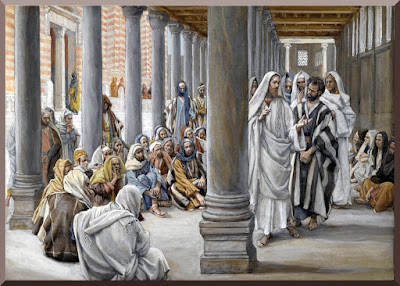Jesus and Hanukkah
“And it was at Jerusalem the feast of the dedication, and it was
winter. And Jesus walked in the temple in Solomon’s porch.” John 10:22-23
Some Jews approached Him and asked Him straight out, “Are
you the Messiah?” (10:24). Jesus had to be careful how He answered
that question. During the festival, masses of Jews, caught up in the
nationalistic fever, were visiting Jerusalem. The word “Messiah” might spark off riots because of its heavy
nationalistic and political overtones.
If Jesus had answered the question “yes,” the
Roman authorities would have arrested Him on the spot for insurrection. Jesus
does, however, answer the question in the favorable, but not directly. When He
answers, He is careful not to use the contemporary term and understanding.
After pointing out the security that a believer in the Lord Jesus has because
of faith in Him, He says, "I and My Father are one!" (10:30).
That statement had heavy religious overtones for the festival which they were
presently celebrating. Those gathered on the Temple Mount recalled the events
nearly 200 years before on the very mount where Antiochus IV, a mere man,
proclaimed himself to be god. Jesus, God manifest in human flesh, made the same
claim—but His claim was true.
The Jews picked up stones to stone Him for
blasphemy because, in their thinking, He was a man who made Himself out to be
God (10:31–33). Jesus declared that He was the fulfillment of Hanukkah by saying the
Father "sanctified" the Son of God and sent Him into the
world (10:34–36). The Father was in Him and He in the Father (10:38). If the
Greek word “sanctified" were translated into Hebrew, it would be “dedication” or Hanukkah!
"Destroy this temple, and in three days I will raise it up." Then the Jews said, “It has taken 46 years to build this temple, and will You raise it up in three days?” But He was speaking of the temple of His body (2:19–21).
A wicked and
corrupt priesthood had defiled Herod’s Temple. The sinless Lord Jesus was
“sanctified” by His death, burial and resurrection and is the New Temple.
The Apostle John selected “signs” (miracles) and events
when he penned his gospel, under the inspiration of the Holy Spirit, to convey
two purposes (20:30, 31). The first was to present the deity of the Lord Jesus.
John skillfully selects the Hanukkah event because of the festival impact on
the crowd.
In contrast to the arrogant and blasphemous statement by
Antiochus IV, Jesus truly is God manifest in human flesh. The second purpose
was to challenge people to put their trust (believe) in the Lord Jesus Christ
as the One who died for their sins and rose again from the dead. When they
trust Him, God gives them the gift of eternal life, forgiveness of sins and a
home in Heaven. There seems to be a marked contrast between the response of the
Jews on the Temple Mount (10:37–39) and those “beyond the Jordan” who
believed on Him (10:40–42).
….to be cont’d
In Christ,
Playwright
Janet Irene Thomas
Founder/CEO
Bible
Stories Theatre of
Fine
& Performing Arts


No comments:
Post a Comment